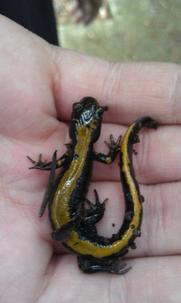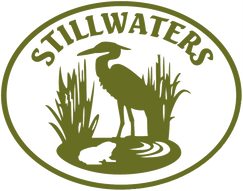Amphibians

In many freshwater systems, amphibians (like frogs and salamanders) make their home. Even if they spend a lot of their time out of the water, they like making sure their skin stays wet: it’s part of how they breathe. Many different species of amphibians can live in the same area, and we can see that in Kingston alone. They play an important role in the ecosystem by preying upon some of the primary consumers and helping the nutrient cycle to continue. Often, they choose what to eat just by what they can see. Sometimes they get flies or mosquitoes, but other times they may grab a seed floating through the water.
Amphibians start out as eggs. The parent either lays the eggs on land or in water or they carry the eggs. When they carry the eggs, some development occurs and the youngling will hatch already partially grown, appearing to be a “small adult”. For the land eggs, the hatched larvae will either make their way to the water alone or will be carried by a parent. The larvae from the water eggs are also often transported by a parent for the first stage of their life. The eggs themselves are very different than eggs we might recognize from a chicken or other large animals: they are see through, gelatinous, and permeable.
There are many spots around Carpenter Creek where you can spot amphibians, and if you see one, take a longer moment to study it. You can tell how it tries to move around based on the size and presence of certain limbs. If it has large hind limbs, it likes to jump or maybe swim (think frogs). Webbed toes are also an indication of swimmers. Smaller limbs indicate they like to dig (some types of frogs and salamanders like to do this). If they have a tail, they may try to climb! Try to look at their hands and feet as well: they typically only have 4 digits (fingers/toes) on the front feet, but 5 on the rear ones.
Amphibians start out as eggs. The parent either lays the eggs on land or in water or they carry the eggs. When they carry the eggs, some development occurs and the youngling will hatch already partially grown, appearing to be a “small adult”. For the land eggs, the hatched larvae will either make their way to the water alone or will be carried by a parent. The larvae from the water eggs are also often transported by a parent for the first stage of their life. The eggs themselves are very different than eggs we might recognize from a chicken or other large animals: they are see through, gelatinous, and permeable.
There are many spots around Carpenter Creek where you can spot amphibians, and if you see one, take a longer moment to study it. You can tell how it tries to move around based on the size and presence of certain limbs. If it has large hind limbs, it likes to jump or maybe swim (think frogs). Webbed toes are also an indication of swimmers. Smaller limbs indicate they like to dig (some types of frogs and salamanders like to do this). If they have a tail, they may try to climb! Try to look at their hands and feet as well: they typically only have 4 digits (fingers/toes) on the front feet, but 5 on the rear ones.


